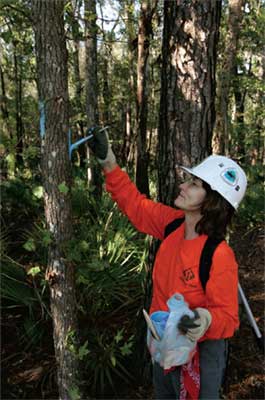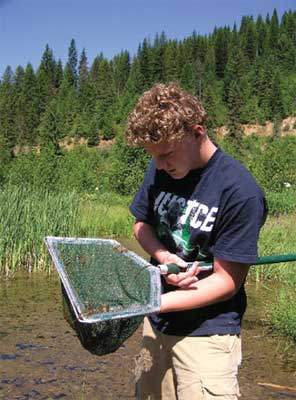Personal Safety
The safety of our volunteers is a primary concern in the Forest Service. We value the tremendous contributions of our volunteers and are responsible for helping them ensure their personal safety.
Maintaining Communication
We provide them with a means of communication. We make sure that there is somebody available to monitor the radio when they are out on the site and that the safety net is under them all the time....we wouldn't do that any differently if that tour leader were a paid seasonal as opposed to being a volunteer.
Pat Thrasher—Midewin National
Tallgrass Prairie
The Health and Safety Code Handbook requires a JHA that includes an emergency evacuation plan. All volunteers must have communication when serving in both office and field settings. In office settings, this is usually not a problem because of access to telephones. In field locations, maintaining communication can be much more difficult (figure 39). If volunteers are serving with Forest Service employees, only the employees need to have communication. If volunteers are serving by themselves, they must carry a two-way radio or cellular phone.
To assign a volunteer a Forest Service radio, use a transfer of property form (appendix D). A cache of radios also can be reserved for volunteers to check out when needed. Make sure the radios and extra batteries are in a location volunteers can access during the week, on weekends, and in the evening. If a volunteer is hearing impaired, you will need to explore alternatives to a radio, such as text messaging devices.
If there are too many dead spots for reliable radio communication, volunteers will have to carry cell phones. With either a cell phone or radio, they will need a map of where reception can be obtained (or where to expect dead spots). If radios or cell phones won’t receive a signal at the field site, volunteers will need to carry a satellite phone. These phones are expensive, but usually solve the problem.

Figure 39—Make sure volunteers who work
in the field stay in contact,
such as this
volunteer on the Florida Trail. Courtesy of Bob
Stone, Florida Trail
Association
Before volunteers carry a radio, cell phone, or satellite phone, ensure they are trained on how to use them and have the correct frequencies and telephone numbers. Also make sure there will be someone on the other end of the line to answer the volunteer's call.
The best contact for a volunteer is an employee associated with the program. A dispatch center can serve as a contact, but make sure you set this up in advance. Volunteers may use family members or friends as contacts, but provide them with the name and number of an employee they can call if necessary. For emergency situations, make sure volunteers have the Forest Service law enforcement or sheriff's office radio frequency and phone number.
One way to ensure your volunteers' personal safety is by having a solid check-out/check-in system (figure 40). Volunteers serving during regular office hours can use the established procedures already in place for employees on most units.
Keeping track of volunteers during off hours poses a particular challenge. Here are some solutions used by experienced coordinators.

Figure 40—A volunteer surveys Tepee Creek Pond
amphibians, an amphibian
survey project for
the wildlife program. Courtesy of Jenny Taylor, Coeur
d’Alene National Forest
For groups of volunteers who serve in the field sporadically, coordinators require one of the volunteers to call a few days before they go out to the site. This individual provides a list of the volunteers who will be serving that day and the name of a person who has agreed to serve as the check-out/check-in contact. This contact may be anyone (family member, friend, another volunteer) who has agreed to ensure the group returns from the field and has the phone number of a Forest Service employee to contact in case of emergency.
On other units, volunteers call an answering machine. They leave a message stating when and where they are going and make sure to call when they get back in. The key to making this system work is to be sure that someone is responsible for checking the messages on a regular basis when volunteers are out.
Protecting Volunteers From Violence
Visitor contact is one of the most common services performed by volunteers. Even though most of these contacts are pleasant, volunteers may occasionally encounter angry individuals who could verbally abuse or even assault them.
We actually had a volunteer who was physically accosted by a member of the public and it was a contact on a trail…. Through the whole conversation, basically the individual he was talking to never really talked, kind of nodded his head…the next thing he knew the guy had jumped on top of him and was about to hit him in the face—had him on the ground. …it really stunned him..
Cliff Dills—Cibola National
Forest, Sandia Ranger District
It is important to train volunteers to protect their personal safety when they contact the public in the field. They will need to know how to assess people and scenes, approach people safely, keep a safe distance, and get out of dangerous encounters. For more information on these topics, refer to the Forest Service "Personal Safety in Remote Work Locations" video series which is also available on DVD (Driessen and Outka-Perkins 2007). Your unit should have a copy of this program. If not, contact your regional safety officer or MTDC for a copy.
Volunteers who serve in the field are not the only ones who may be confronted by angry visitors. It is also important to protect office volunteers by designing the reception area with two escape routes, locking back doors, and installing panic buttons. A program on the personal safety of front liners (persons who make the first contacts with the public) will be available from MTDC by the winter of 2009.
